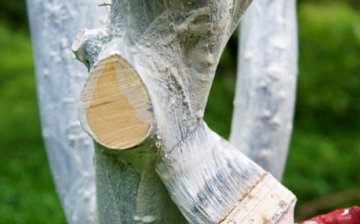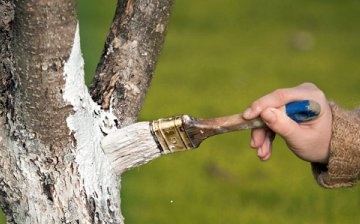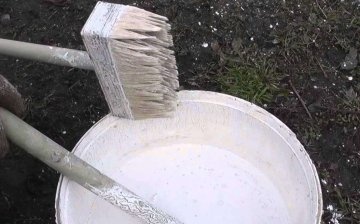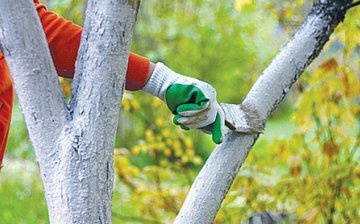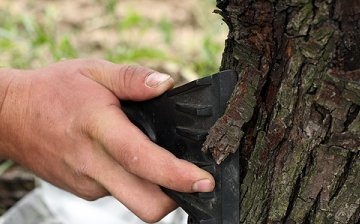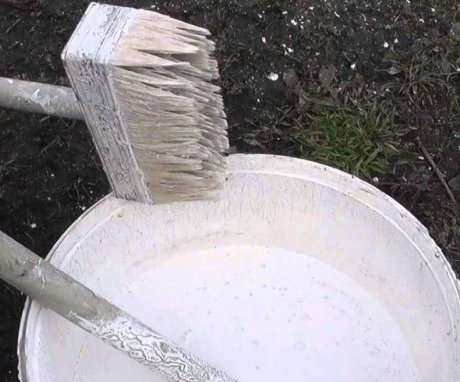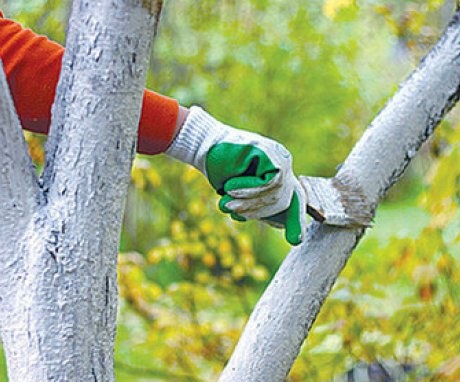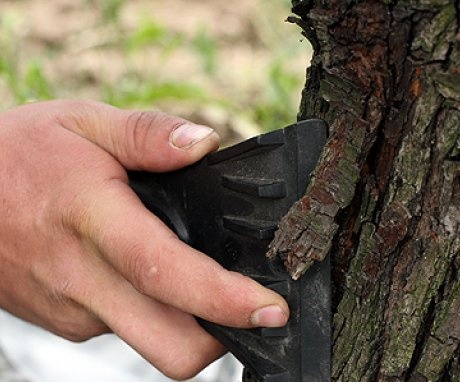Why are tree trunks in the garden whitewashed?
Everyone has seen trees with whitewashed trunks in gardens or within the city. We used to think that this is done for aesthetic purposes, in fact, whitewashing trees has many different functions. This is a necessary and indispensable procedure to protect all trees, not just fruit trees.
Content:
- Why are tree trunks whitewashed
- How and what to whitewash trees in the garden
- Terms of whitewashing and recommendations
- Preparing trees for whitewashing
Why are tree trunks whitewashed
Whitewashing plays not only a decorative role. Its main task is to protect the tree bark from adverse environmental conditions. The bark of a tree, like human skin, acts as a barrier, preventing pests, bacteria and infections penetrate deeper and more sensitive tissues. She is daily faced with temperature extremes, sunlight, pests, human exposure, insects.
Over time, the bark begins to coarse and crack, damage appears in it, through which insect larvae and infections enter. Therefore, the main reason why tree trunks are whitened is to strengthen the protective properties of tree bark.
The bark of young seedlings and already mature trees equally needs whitewashing.
The solution contains lime. Many gardeners are afraid to whitewash young trees due to the toxic effects of lime, but for young bark, you can simply choose different proportions or buy a special safe paint.
The main functions of whitewashing trees:
- Sun protection. The sun can damage the bark, dry it out, and cause cracks and damage. Even in February, the sun's rays are damaging to the bark of trees, despite the deceptive cold. For this reason, all solutions and paints for treating tree trunks are white, which reflects the sun's rays and prevents the tree trunk from getting too hot.
- Protection against temperature extremes. In both cold and warm seasons, temperature drops occur. During the day, the sun heats up the air, and at night it gets cool or cold. Such changes negatively affect the condition of the cortex. It begins to crack, damage is formed in it, opening access for infections. Whitewashing not only thickens the top layer of the bark, preventing it from cracking, but also has an antifungal effect.
- Protection from pests. The bark of trees is adored by small rodents, as well as insects. To scare off pests and prevent insects from settling in cracks in the bark, the trunks are whitewashed annually.
How and what to whitewash trees in the garden
You can whitewash the lower part of the trunk, or you can whitewash the entire trunk to the lower tier of branches. Some gardeners whitewash the branches themselves, which they can reach. Of course, whitewashing the whole tree will be much more effective, but this is too time-consuming and expensive process. It is enough to whitewash the trunk to the lower branches. It is this part that hares love and insects often settle in it. This part of the tree is usually covered with the most old bark.
The whitewashing process is extremely simple: you need to carefully cover the tree trunks to the desired height with a prepared family and a regular paint brush. If the layer seems too transparent, you can whitewash the trunk a second time.You can purchase a ready-made solution for whitewashing in a specialized store, but experienced gardeners recommend making the solution yourself in order to maintain the proportions and control the quality of the components.
Types of whitewashing for trees:
- Lime mortars. You can prepare such a solution from ordinary lime, glue and copper sulfate. Glue (you can replace it with clay) is needed so that the coating adheres and does not wash off with the first rain. Casein glue is the best fixer. Copper sulfate serves as an excellent antiseptic. If the tree is young, the amount of lime can be reduced. If desired, manure can be added to such a solution. All components are diluted in certain proportions in 10 liters of water. For an adult tree, it is better to take at least 1 kg of lime.
- Water-based paint. It is also a fairly effective whitewash tool, you can find it in stores. You don't need to cook anything. However, lime mortars are believed to have many positive effects and are much cheaper than paints.
- Acrylic paint. Acrylic paint works well and lasts a long time, looks aesthetically pleasing, but is quite expensive.
Trees can be whitened with a brush, roller or special spray. The solution should not be too thick, but also not so liquid that it drips from the tree during whitewashing.
Terms of whitewashing and recommendations
Many people associate the whitewashing of trees with the spring cleanup. Indeed, in the spring, it is customary to update the whitewash, but this procedure is belated. The most effective and important whitewashing for a tree is carried out in the fall, in October-November. It is the autumn preparation that includes whitewashing the trunks.
It seems that the sun warms slightly in winter, but the sun's rays still damage the bark. In February, the most dangerous time comes when the sun heats up the trunk so much that the process of sap flow begins in it. At night, the temperature drops and the sap freezes, injuring the tree. If whitewashing was not carried out in the fall, you need to do this in December-January to prevent damage to the bark. In the spring and summer, you can simply update the whitewash if necessary.
As a rule, after winter, the whitewash cracks and crumbles from frost, so it is advisable to apply a new layer in April.
Whitewashing will slightly postpone the term flowering tree, but it will benefit him, since the likelihood of infection and damage to the trunk will be minimal. In summer, whitewashing may not be carried out if the spring layer is still present.
When whitewashing trees, you need to adhere to some rules and know the intricacies of this procedure. Whitewashing rules for trees:
- No need to regret the solution when applying. The whitewash layer should be quite dense. When using mortar, the whitewash may be pale at first, but will brighten after a few hours.
- Whitewashing can only be done in dry weather, otherwise the solution will not have time to grab.
- Even if you choose to color the trunks for beauty, the bottom of the trunk and most of it should be white. It is the white color that has the ability to reflect the sun's rays.
- If you buy paint, it must be special. On these jars write "paint for garden trees." You cannot apply any paint that has fallen over the bark, otherwise you can harm the tree, moreover, ordinary paint does not have a disinfecting effect.
Preparing trees for whitewashing
Before you start whitewashing, you need to carefully prepare the tree. Preparatory work is very important, the quality of whitewashing largely depends on their effectiveness:
- The preparation process begins with cleaning the barrel. It accumulates mosses, dust, dirt, lichens. Cleaning should be done with gentle materials. For this purpose, you can use cloth gloves or a soft washcloth. It is best to clean in wet weather.Some gardeners use more aggressive cleaning methods, such as with a wire brush or putty knife. Such cleaning will be appropriate if the tree is old and the bark is rather thick and dry. It is necessary to carefully remove the top old layer, taking care not to damage the living tissue under the bark layer. Do not let the cleaners fall to the ground during cleaning. It is necessary to spread polyethylene, collect all the cleanings, and then burn them, as they may contain fungi and insect larvae.
- After cleaning, you need to proceed with disinfection. All surfaces that have been cleaned must be disinfected. During cleaning, the lower protective layers are exposed, small cracks appear, and the tree becomes defenseless against infections. Disinfection can be carried out using a mixture ash, a solution of laundry soap, as well as just ash lye. To get it, you need to mix ash and water and boil. After settling, everything above the sediment is ash liquor. A solution of ferrous sulfate has good disinfecting properties, but such a solution cannot be used annually, since iron accumulates in the bark, poisoning the tree.
- After disinfection, the stage of wound treatment begins. After cleaning the bark, all wounds are clearly visible. Each of them needs to be processed. For these purposes, you can use a garden pitch, which can be purchased in a store or made yourself from tree resin and linseed oil, rosin, wax, alcohol and lamb fat, etc. For treating wounds, any disinfecting purchased garden pastes and putties are perfect.
The whitewashing procedure should not be treated as something secondary. Regular whitewashing helps the tree stay healthy, bloom and bear fruit.
More information can be found in the video:



